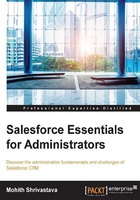
What this book covers
Chapter 1, User Management and User Profiling, discusses the process of creating users in Salesforce and how licensing is managed. This chapter will discuss delegated administration in detail. In profile management, we will discuss how to manage profiles, field accessibility, various system permissions, the need for permission sets, mobile configuration, object permissions, the Apex class and Visualforce page access, and the Salesforce A application for the administrator.
Chapter 2, Configuring Salesforce, discusses the configuration components that cover data modeling, validations, record types, page layout configurations, workflows, approval process configurations, formula fields, and e-mail templates.
Chapter 3, Reports and Dashboards, explains the various types of reports and dashboards. It discusses analytic snapshots and the usage of the PARENTGROUPVAL and PREVGROUPVAL summary functions.
Chapter 4, Record-level Access, Security, and Audit Features, explains OWD, the sharing settings, manual sharing, role hierarchy, and audit features provided by the Salesforce platform.
Chapter 5, Session Management, Data Loader, and Data Loading Best Practices, focuses on the basic data-loading concepts using data loader, session management, and password-protection policies.
Chapter 6, Troubleshooting Common Problems, consists of common real-time business problems and the best practices and techniques to solve them using the components provided by the Salesforce CRM.
Chapter 7, An Overview of Sales and Service Cloud, discusses the sales cloud features in brief, which includes territory management and forecasting. It also discusses service cloud features such as entitlement management, knowledge management, and content management. This chapter ends with a discussion on Salesforce as a maturity model.